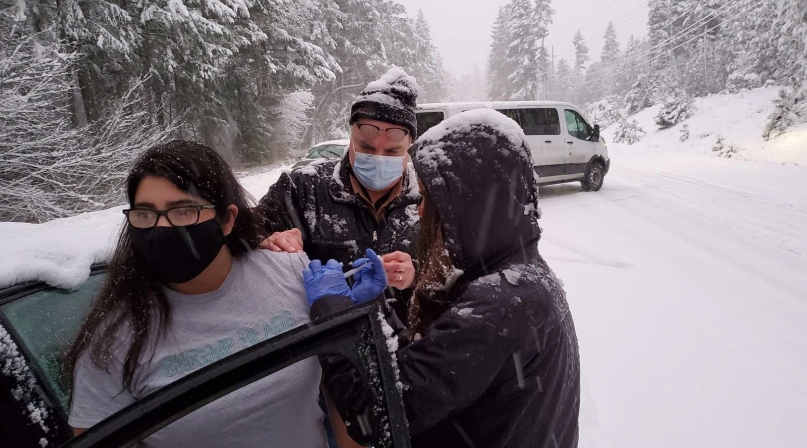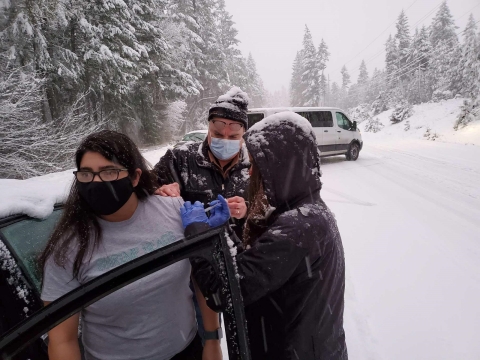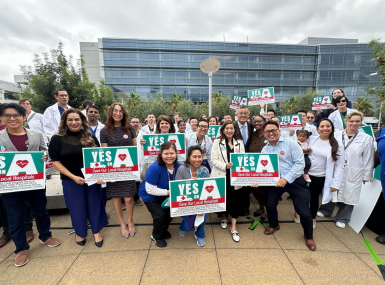COVID-19 vaccines: Don’t waste a single drop
Author
Upcoming Events
Related News

Key Takeaways
It was an obvious choice for Josephine County, Ore. Public Health Director Mike Weber.
“Wasting vaccine really wasn’t on the table,” he said.
Weber found himself and staff members from the Josephine County Public Health Department stranded on Highway 199 after a snowstorm stopped them in their tracks. The group had just finished a vaccination event at a local high school and had six unused doses. The storm prevented Weber and his staff from transporting the vaccines to intended recipients in the county seat of Grants Pass before they would expire.
Learn More
Key considerations for counties in COVID-19 vaccine distribution plans
After approaching over 40 vehicles, all six of the vaccines were in someone’s arm.
“People don’t anticipate somebody knocking on your car window in a snowstorm and saying would you like a needle in the arm so that uniqueness made it memorable and frankly, a little bit fun,” Weber said.
Other counties across the country are taking these extra measures to ensure every dose of the vaccine is used without being discarded or wasted.
In Tuscarawas County, Ohio, the health department launched the “No Waste Waitlist” to ensure all vaccines get into someone’s arm.
Tuscarawas County Health Commissioner Katie Seward explained how both the Moderna and Pfizer vaccines have a shelf life. With the Moderna vaccine specifically, Seward said they use 10-dose vials. As soon as the vile is punctured for the first dose, it has six hours to be used before it expires.
While the county tries to schedule in groups of 10 for vaccinations to use the entire vile, Seward said they have been experiencing no-show rates between 5 and 10 percent.
County residents can sign up on the No Waste Waitlist to potentially receive a leftover vaccine. If they receive a call from the health department, they have 40 minutes to arrive for a drive-up appointment to receive the shot.
“It’s really about ensuring that everyone gets the vaccine at some point and so we’re going to do that as efficiently as possible and make sure that we’re not wasting a single drop,” Seward said.
More than 4,000 people have signed up on the list. As of the last week of January, six individuals who were on the list received vaccines and scheduled appointments to come back for the second dose.
With the health department’s weekly allotment of 100 vaccines, Seward said she has a few other lists to help with distribution— one for those who are 75 years or older and one for no-show rates for those who missed an appointment for the second dose.
“We have a real responsibility to be as transparent with the public as possible to gain their confidence that we’re doing everything we can to be responsible with the doses we have,” she said.
The Vanderburgh County, Ind. Health Department also established a COVID-19 vaccine back-up list.
The online form asks for names, ages, birthdays and co-morbidities and stores all information in a database managed by the department, Vanderburgh County Health Department Administrator Joe Gries said.
Staff can sort through the database by age to identify those closest to the current phase to administer leftover doses. Around 20 to 25 people on the list received a call to come to the clinic and receive a vaccine, Gries said. They are then set up with an appointment for the second dose.
“We don’t want to make anything go into the waste can because it’s too valuable right now,” he said.
Coordination is key in ensuring no vaccines are wasted. Gries described how the health department works with local hospitals, vaccination team leaders, local health departments and the state health department to ensure an efficient vaccine distribution process.
“As long as we’re following the protocols making sure that we have everything in place here locally, we’re not going to ever really have to worry about discarding vaccines or having doses go to waste,” he said.
It also takes a coordinated effort for distribution in Kittitas County, Wash., where the county health department has not wasted any vaccines.
Kasey Knutson, Kittitas County Public Health Department Special Programs coordinator, said the department works closely with the local hospital and the county incident management team to utilize waitlists and ensure all vaccines are administered.
The waitlist, which is online, is for individuals who meet the phases released by state guidance. At its peak, 4,100 individuals had signed up and Knutson said they have started vaccinating those on the list and setting up appointments for others.
The incident management team, which is experienced in responding to other emergencies throughout the county, handles the vaccine distribution working with partners and volunteers to distribute all vaccines.
“I think the keys are the partnerships and having that system in place so having the personnel ready to respond and knowing who’s getting the dose, when are they getting the dose, making sure you have vaccinators to provide that,” she said.

Attachments
Related News

CMS issues new guidance on Medicaid Community Engagement Requirements
On December 8, the Centers for Medicare & Medicaid Services (CMS) released a Medicaid and CHIP Services Informational Bulletin (CIB) directing states on how to implement the Medicaid community engagement requirements enacted under Section 71119 of the One Big Beautiful Bill Act legislation (Public Law 119-21), or H.R. 1.

California county sales tax measure backfills federal healthcare cuts
Santa Clara County, Calif. will raise an estimated $330 million each year from a sales tax to backfill lose Medicaid funding.

